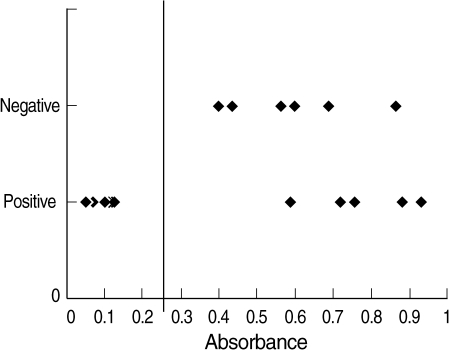Toxoplasma gondii is a worldwide endemic parasite, and a member of the phylum Apicomplexa, subclass coccidian. It can infect most warm-blooded animals and humans, and can occasionally cause permanent neurological damage, with or without hydrocephalus, or chorioretinitis. Infections with this zoonotic agent are acquired principally by eating food or water contaminated with oocysts or tissue cysts of T. gondii. Cats have an important role in the spread of toxoplasmosis, because they are the only animal that excretes resistant oocysts into the environment. A single cat may shed more than 100 million oocysts into the environment [1,2]. Internationally, the presence of large populations of feral cats have become a controversial issue, due to their impact on cat overpopulation, animal welfare, public health, and the environment, and also due to disagreements about the best methods for their control [3]. Also in Korea, large numbers of stray cats are found roaming residential streets and have become a target of public grievances. They disrupt people's sleep, make noise, and cause traffic accidents, and this has been a fairly serious issue since 2000. In addition, they threaten the population as a source of zoonotic diseases, including toxoplasmosis. Chai et al. [4] successfully isolated and maintained the T. gondii parasite from a Korean ocular patient, which was designated the Korean Isolate-1 (KI-1).
Seroprevalence of T. gondii infection in stray and household cats were reported in Spain [5], Tehran [6], China [7], and Japan [8]. Whereas in Korea, several epidemiological surveys of T. gondii in just stray cats have been conducted in recent years [9-11], and no researchers have, until now, conducted a comparison of prevalence of T. gondii infections in household and stray cats in the same area. It should be noted that the precise disposition of the household cat population remains obscure. Therefore, the present study was first conducted to investigate the prevalence of T. gondii infection in stray and household cats in Seoul, Korea, via ELISA and nested PCR analyses.
A total of 80 household cats and 72 stray cats were subjected in this study. Blood samples of household cats were collected whenever they were admitted to a veterinary clinic by their owners for regular health check-ups. On the other hand, blood samples of stray cats were received from other veterinary clinics, located in the same areas where the household cats' samples were obtained, through the local government's TNR (Trap, Neuter, Return) program, the purpose of which was to reduce the numbers and control the natural reproduction rates of urban stray cats. A total 9 areas, Jungrang, Nowon, Dongdaemun, Gangnam, Gwangjin, Seongbuk, Dobong, Songpa, and Gangbuk, in Seoul were surveyed (Fig. 1). All samples were collected from April to September 2008. Blood samples were collected from cephalic or jugular punctures of each cat, permitted to clot at room temperature and centrifuged for 5 min at 1,800 g. Serum and whole blood were collected after centrifuging and transferred to the Division of Malaria and Parasitic Diseases at the Korea Centers for Disease Control and Prevention.
General methods of DNA extraction were carried out by the manufacturer's instructions using the DNeasy Mini column kit (Qiagen, Hilden, Germany). The DNA concentration of each blood sample was measured with a Quant-iT™, dsDNA HS Assay Kit (Invitrogen, Carlsbad, California, USA) and read by Qubit™, Fluorometer (Invitrogen), and the average DNA concentration was 15 ng and the range was a minimum 7 ng to a maximum 46 ng. All samples were stored at -20℃ until used. ELISA for toxoplasmosis was performed essentially in accordance with the procedure of Choi et al. [12] and a nested PCR targeting the specific B1 gene for T. gondii was followed according to the condition with Kim et al. [9]. The PCR products were purified using the QIAquick PCR purification kit (Qiagen, Valencia, California, USA) and sequenced by a commercial laboratory (Macrogen, Seoul, Korea).
Our study involved 72 stray cats (32 males and 40 females) and 80 household cats (40 males and 40 females, spay 4, and aged 4 months to 7 years) and they had no specific symptoms in external appearance. As the seroprevalence of T. gondii in cats varied depending on their living type (stray or domestic), age, the diagnostic method used, and geographic area [13], the prevalence of T. gondii in stray cats has been reported to be variable from 5% to 45% in recent years in Korea [9-11].
The results of this study were similar to the previous reports. The overall positive population of T. gondii in stray cats was 38.9% (28/72); the rate was 15.3% (11/72) by ELISA and 30.6% (22/72) by nested PCR (Table 1). The positive rate of T. gondii in nested PCR analysis was 2 times higher than that of ELISA and the positive samples only in ELISA showed absorbance of 0.4-0.9 (over the 0.25 cut-off value), while the range of positives in both ELISA and nested PCR was wider, from 0.1-0.9 (Fig. 2). This was similar to the reports by Kim et al. [9] and the development of a highly sensitive and specific PCR will help in the early diagnosis of toxoplamsosis in blood [14,15]. In terms of sex, the male positive rate was 18.8% (6/32) and the female rate was 12.5% (5/40) in stray cats by ELISA, and 28.1% (9/32) in males and 32.5% (13/40) in females by nested PCR (Table 2). The positive rate of T. gondii in male cats was slightly higher than that in females. Similar [5] or opposing [6,7,9] results have been reported. Regionally, the prevalence of T. gondii varied and the highest positive rates of T. gondii infection were noted in Gangnam and Songpa for ELISA, and Gwangjin for nested PCR (Table 2). However, it was not possible to directly compare the prevalences of T. gondii infection in different areas because of a difference in the sample numbers and environmental characteristics of each region.
Our study of household cats was relatively important, because the prevalence of T. gondii in household cats in Korea has never been assessed until now. According to reports in other nations, the prevalence of T. gondii in household cats was 25.5% in Spain [5], 36% in Tehran [6], 17.9% in China [7], and 5.4% in Japan [8]. In most reports, the prevalence of stray cats was higher than that of household cats in the same area. However, interestingly, we could not detect any specific antibodies and DNA of T. gondii in household cats. By this interesting result, the authors could assume that most household cats are managed quite well by their owner's. Stray cats in Seoul are important wild animals because they occupy the highest position in the urban food-chain and their numbers gradually increased [10]. These cats establish territory in the same fashion as wild animals and generally kept out of other cats' way in each area. Therefore, it is assumed that the life cycle of T. gondii is maintained in the territory of each cat and in each area. Concurrently, a potential zoonotic threat to humans and animals remains a concern in all of them [9].
In conclusion, toxoplasmosis is widespread among stray cats of Seoul, whereas household cats are not infected. Further epidemiologic surveys of toxoplasmosis in stray cats from various areas in Seoul and studies of the life styles of household cats will be need in order to gain a more complete understanding of T. gondii infection.








